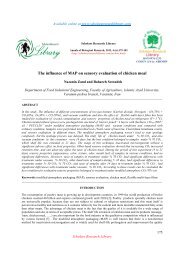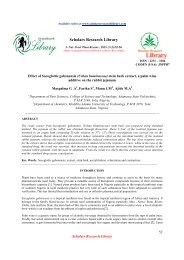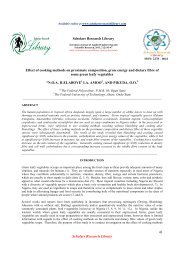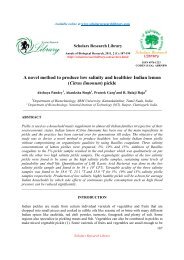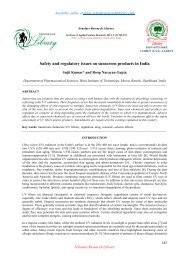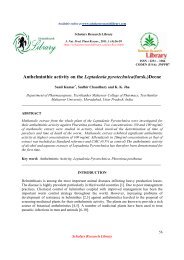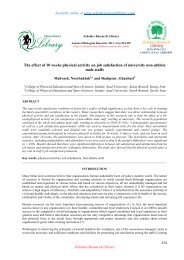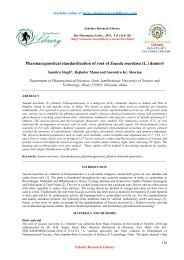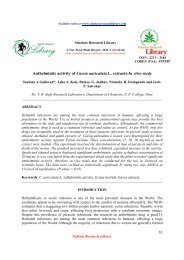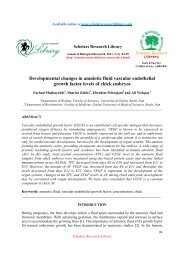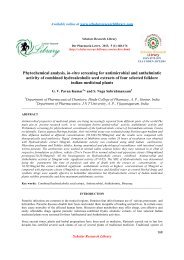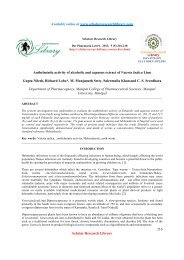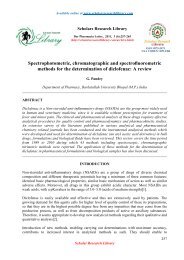Proximate and chemical composition of OGI prepared from whole ...
Proximate and chemical composition of OGI prepared from whole ...
Proximate and chemical composition of OGI prepared from whole ...
Create successful ePaper yourself
Turn your PDF publications into a flip-book with our unique Google optimized e-Paper software.
Available online at www.scholarsresearchlibrary.com<br />
Scholars Research Library<br />
Annals <strong>of</strong> Biological Research, 2013, 4 (7):239-242<br />
(http://scholarsresearchlibrary.com/archive.html)<br />
ISSN 0976-1233<br />
CODEN (USA): ABRNBW<br />
<strong>Proximate</strong> <strong>and</strong> <strong>chemical</strong> <strong>composition</strong> <strong>of</strong> <strong>OGI</strong> <strong>prepared</strong> <strong>from</strong> <strong>whole</strong> <strong>and</strong><br />
powdered grains (Maize, Sorghum <strong>and</strong> Millet)<br />
O. O. Pikuda <strong>and</strong> *N. O. Ilelaboye<br />
Department <strong>of</strong> Science Laboratory Technology, Ilaro, Ogun State, Nigeria<br />
_____________________________________________________________________________________________<br />
ABSTRACT<br />
Ogi was <strong>prepared</strong> by steeping <strong>whole</strong> grains <strong>and</strong> powdered grains in water for 72 hrs <strong>and</strong> 18 hrs respectively. Crude<br />
Protein, Crude Fat, Crude Fibre <strong>and</strong> Total Ash content was higher in ogi <strong>prepared</strong> <strong>from</strong> steeped <strong>whole</strong> grains than<br />
those made <strong>from</strong> steeped powdered grains for all the grains used. Nitrogen free extract was observed to be higher<br />
in ogi made <strong>from</strong> steeped powdered grains. All the minerals (Fe, Zn, Mg, Na, K <strong>and</strong> Ca) analysed were lower in ogi<br />
<strong>prepared</strong> <strong>from</strong> powdered grains. However the results shows that the removal <strong>of</strong> antinutrients (cyanide, phytate <strong>and</strong><br />
Tannin) was achieved more using steeped powdered grains to prepare ogi, though cyanide was not detected in ogi<br />
made <strong>from</strong> millet. Steeping <strong>of</strong> all the grains before milling is a better method because it produced ogi with a better<br />
nutritional quality.<br />
_____________________________________________________________________________________________<br />
INTRODUCTION<br />
One <strong>of</strong> the strategies used for child survival the world over includes prolonged <strong>and</strong> intensive breastfeeding. The<br />
breast milk is introduced to the infant as early as possible <strong>and</strong> this is done exclusively for the first six months <strong>of</strong><br />
life[1]. In Nigeria, exclusive breastfeeding is usually practiced up to three to four months; this may not be able to<br />
support the nutritional needs <strong>of</strong> the infant after this period. Therefore s<strong>of</strong>t easily swollen foods are introduced to<br />
supplement the child’s feeding(i.e. weaning). Infants especially <strong>of</strong> the poor rely on ogi as a major weaning meal[2].<br />
Ogi also known as agidi is a fermented product usually <strong>from</strong> maize which is grown in all parts <strong>of</strong> Nigeria. It is<br />
known that the traditional method <strong>of</strong> processing ogi results in loss <strong>of</strong> nutrients[3].<br />
The present study is aimed at producing ogi (agidi paste) <strong>from</strong> grains commonly used in Nigeria, i.e. yellow maize,<br />
white maize, millet <strong>and</strong> sorghum using both steeped <strong>whole</strong> grains (traditional method) <strong>and</strong> steeped powdered grains.<br />
The effect <strong>of</strong> processing method on the nutrient status <strong>of</strong> the ogi paste so produced is thus investigated.<br />
MATERIALS AND METHODS<br />
Sampling <strong>and</strong> Sample preparation: White <strong>and</strong> Yellow maize(Zea mays), Sorghum(Sorghum bicolor) <strong>and</strong><br />
Millet(Pennisetum glaucum) were purchased <strong>from</strong> a local market in Ilaro, Ogun state ,Nigeria. The grains were<br />
sorted to remove damaged ones. Each grain type was divided into two portions, ogi was <strong>prepared</strong> <strong>from</strong> one using<br />
<strong>whole</strong> grains while the second portion was used to prepare ogi using powdered grains.<br />
Steeping <strong>of</strong> Whole Grains:100g <strong>of</strong> each grain type was steeped in distilled water for three days[4]. The grains were<br />
then rinsed in clean water, wet milled <strong>and</strong> sieved. The filtrate was allowed to settle <strong>and</strong> the water was drained <strong>of</strong>f.<br />
Scholars Research Library<br />
239
N. O. Ilelaboye et al Annals <strong>of</strong> Biological Research, 2013, 4 (7):239-242<br />
_____________________________________________________________________________<br />
Steeping <strong>of</strong> Powdered Grains: 100g <strong>of</strong> the grains were milled into flours respectively <strong>and</strong> steeped in distilled water<br />
for eighteen hours[5]. It was sieved, filtered <strong>and</strong> allowed to settle. The water was drained <strong>of</strong>f <strong>and</strong> the resulting<br />
product is the ogi.The pastes produced were kept in well labeled air tight polythene bags in a refrigerator for further<br />
analysis.<br />
Methods: Triplicate samples were taken for proximate <strong>composition</strong> determination using the methods <strong>of</strong> AOAC[6]<br />
for moisture, crude fat, crude fiber, ash <strong>and</strong> protein. A nitrogen conversion <strong>of</strong> 6.25 was used. Carbohydrate was<br />
calculated by difference, energy values were calculated by multiplying protein, fat <strong>and</strong> carbohydrate by Atwater<br />
factor 4.9.4[7] respectively.<br />
Triplicate samples were also taken for minerals <strong>and</strong> antinutritional factors determination. Prior to mineral analysis<br />
samples were digested with a triacid mixture (concentrated nitric, perchloric <strong>and</strong> sulphuric acids, 4.0:5.0:0.5 v/v).<br />
Zinc, Iron, Calcium <strong>and</strong> Magnesium were analysed by Perkin Elmer, model 403 atomic absorption<br />
spectrophotometer. Sodium <strong>and</strong> Potassium were analysed using flame photometry. Tannic acid was determined in<br />
accordance with the procedure <strong>of</strong> AOAC[6]. Phytic acid determination was done in accordance with the procedure<br />
<strong>of</strong> Ruales <strong>and</strong> Nair[8]. The cyanide content was determined by the procedure described by De Bruijin[9].<br />
The data obtained <strong>from</strong> the analysis was subjected to statistical analysis using univariate analysis <strong>of</strong> variance <strong>and</strong><br />
significant treatments <strong>of</strong> means were separated by the multiple range test <strong>of</strong> Duncan according to the procedure<br />
stated in SPSS package[10].<br />
RESULTS AND DISCUSSION<br />
The percentage proximate <strong>composition</strong> <strong>of</strong> ogi on dry matter basis is as presented in table 1.<br />
Generally ogi produced using steeped powdered grains looses more nutrients than the traditional method. Based on<br />
the traditional method, millet(SM) ogi has the highest protein content (15.3%) followed by sorghum(SS,13.8%) then<br />
yellow maize(SYM,7.60%) <strong>and</strong> lastly white maize(SWM,7.29% ). Sorghum ogi has the highest fibre<br />
content(2.86%) while yellow maize(SYM) has the least fat content(4.27%). Sorghum ogi (SS) is the richest in ash<br />
content while yellow maize ogi(SYM) is the poorest in ash content(0.46%).<br />
Table 1: <strong>Proximate</strong> Composition Of ‘Ogi’[% Dry Matter]<br />
Treatments Protein Fibre Fat Ash NFE<br />
SWM 7.29 d* .68 c 6.22 g .49 a 85.37 d<br />
SWMP 4.53 a .55 b 4.27 c .24 a 87.46 g<br />
SYM 7.60 e .43 a 4.79 d .46 a 86.52 e<br />
SYMP 5.29 b .39 a 3.56 b .35 a 90.43 h<br />
SM 15.13 h 1.38 e 5.17 e 1.76 c 76.57 b<br />
SMP 9.96 f 1.21 d 3.52 b .87 b 84.05 c<br />
SS 13.84 g 2.86 f 5.33 f 2.22 d 75.77 a<br />
SSP 7.17 c 2.82 f 2.91 a .86 b 87.06 f<br />
±SEM ** .75 .20 .22 .14 1.03<br />
* Mean values in a row denoted with different superscript are significantly different [p
N. O. Ilelaboye et al Annals <strong>of</strong> Biological Research, 2013, 4 (7):239-242<br />
_____________________________________________________________________________<br />
Table 2: Mineral Composition Of Ogi (Mg/100g Dry Matter)<br />
Treatments Fe Zn Ca Mg Na K<br />
SWM 62.19 d* 7.77 g 180.24 g 111.79 g 300.52 g 191.42 g<br />
SWMP 57.26 c 6.76 e 121.64 c 100.65 d 240.53 d 165.29 f<br />
SYM 84.15 f 8.36 h 153.41 e 104.86 e 270.31 f 126.01 b<br />
SYMP 78.11 e 7.44 f 105.68 b 93.35 c 216.51 c 105.65 a<br />
SM 86.19 g 5.22 d 160.26 f 83.44 b 65.27 b 165.30 f<br />
SMP 52.05 a 4.74 c 103.15 a 73.36 a 53.80 a 141.42 d<br />
SS 97.23 h 2.26 b 205.10 h 121.90 h 326.13 h 159.33 e<br />
SSP 54.44 b 2.18 a 139.75 d 107.68 f 265.76 e 134.93 c<br />
±SEM ** 3.33 .47 7.00 3.07 20.10 5.26<br />
* Mean values in a row denoted with different superscript are significantly different [p
N. O. Ilelaboye et al Annals <strong>of</strong> Biological Research, 2013, 4 (7):239-242<br />
_____________________________________________________________________________<br />
<strong>of</strong> the powdered grain increased the rate <strong>of</strong> leaching <strong>of</strong> the nutrients <strong>of</strong> the grains into the steeping water. Hence<br />
traditional methods (steeping <strong>of</strong> <strong>whole</strong> grain) <strong>of</strong> producing ogi is more preferred.<br />
REFERENCES<br />
[1] A. Davies- Adetugbo Social Science <strong>and</strong> Medicine, 2009Volume 45 Issue 1, 113-125<br />
[2] E.O.I Banigo,. <strong>and</strong> H.G.Muller. Cum.Inst.Food Sci.Technol.JS: 1972 217-221 .<br />
[3] E.N.T. Akobondu, <strong>and</strong> F.H.Hoskins. J. Food Sci; 1982 47: 1728-1729<br />
[4] J.O. Akingbala, L.M. Rooney <strong>and</strong> J.M. Faubion. J. Food Sci; 198114:1523-1526.<br />
[5] J.O. Akingbala, E.U. Onochie.I. A. Adeyemi <strong>and</strong> G.B. Oguntimehin Journal <strong>of</strong> Food Processing <strong>and</strong><br />
Preservation, 1987Vol.11, Issue 1, 1-11<br />
[6] AOAC Association <strong>of</strong> <strong>of</strong>ficial Analytical Chemists. Official methods <strong>of</strong> Analysis Washington DC. 1995<br />
[7] D.R. Osoborne <strong>and</strong> P. Voogt (Eds) Calculation <strong>of</strong> calorific values in: The analysis <strong>of</strong> nutrients in foods.<br />
Academic press, New York. 1978<br />
[8] J. Ruales <strong>and</strong> B.M. Nair: Food Chem., 1993 48:137 – 143.<br />
[9] G.H. De Bruijin Meded Lanb Sch. Wagenn 1971 71: 13 1 -140.<br />
[10] SPSS for Windows, Statistical Package for Social Science, 11 th Edn. Lead Technologies Inc. 2001<br />
[11] Institute <strong>of</strong> Medicine Dietary Reference intake for Vitamins <strong>and</strong> Minerals. Washington DC; National<br />
Academy Press. 2001<br />
[12] I.Vaintraub, <strong>and</strong> V. Bulmaga J. Agric. Food Chem., 1991 39:859-61.<br />
[13] V.A Aletor Vet. Hum. Tox 19935:1, 56 – 57<br />
[14] J. Kwok Cyanide Poisoning <strong>and</strong> Cassava. Food Safety Focus. 2008<br />
[15] C.M. Berlin. Jr Pediat. 1970 46, 793-796.<br />
Scholars Research Library<br />
242



